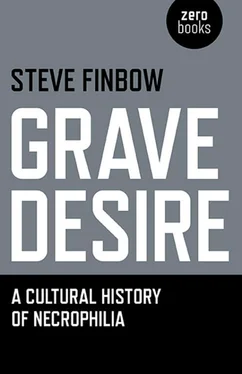Both Žižek and Home, with varying degrees of humour, irony and icononoclasm, view the dead body as an object that becomes a commodity of desire, an erotic vessel, a sex doll; a receptacle not of a transgressive sexual act but a reference to the shifting paradigms and rhizomic networks of human morality and sexuality. [108] See Patricia MacCormack, ‘Necrosexuality,’ Rhizomes 11/12, fall 2005/spring 2006, http://www.rhizomes.net/issue11/maccormack/index.html
4
Necronaut—Sergeant Bertrand
Sixteen years before Queen Victoria’s beloved consort died, a French soldier, already eroticized by corpses and entrails had an idea. To satisfy his lust, rather than happening upon dead bodies, he would disinter them. It was 1845, France was moving toward the end of King Louis-Philippe’s July Monarchy, the philosophies of Romanticism and Anarchism were provoking revolt, coups, and calls for democratic government. Across the English Channel, Sir John Franklin and 134 men set sail on HMS Erebus and HMS Terror in the tragic lost expedition to find the Northwest Passage; while across the Atlantic, Henry David Thoreau began his years of civil disobedience, living in a cabin near Walden Pond. Sergeant Bertrand, intent on his obsession, would begin his years of sexual disobedience by ripping out the guts of cadavers and masturbating over then.
Born in 1822 (or 1824), François Bertrand attended the theological seminary of Langres. As Bertrand described in his confessional interview with doctors after his capture, ‘I began to masturbate at a very tender age without knowing what I was doing; I did not conceal myself from anyone. It was not until the age of eight or nine that I began to think of women, but this passion did not become really strong until the age of thirteen or fourteen.’ [109] Quotes and details of Bertrand’s crimes taken from L. Thoinot, Medicolegal Aspects of Moral Offenses, trans. Arthur W. Weysse (Philadelphia, 1923), pp. 449-458.
Facts about his early years are sketchy but Bertrand admits to one of the classic indicators of necrophilia and of serial killing, ‘seeing that it was impossible for me to have human bodies, I sought out the dead bodies of animals, which I mutilated as I later mutilated those of women or men. I cut open their bellies, and after having torn out the entrails, I masturbated while looking at them.’ These animals included horses, dogs and cats. Once he joined the army in 1842, his bestial necrophilia continued and he states that while at the army ‘camp of Villette in 1844, I did not delay going to the Saint-Denis canal to take out animals that had been drowned, dogs, sheep.’ As a young soldier, he was popular with comrades and attractive to women but his necrophiliac tendencies began to increase, ‘In 1846 I was no longer satisfied with dead animals; I had to have living ones. At the camp of Villette as in all barracks, there were many dogs, which, belonging to no one, followed the soldiers indiscriminately. I resolved to take some of these dogs into the country and kill them… I tore out their entrails.’
In Late February 1847, near Tours, in the village of Bléré, Sergeant Bertrand’s company, part of the 74 thRegiment, billeted near the East Cemetery. After a walk with a fellow soldier through the valleys and hills, Bertrand and his comrade in arms entered the cemetery. There, Bertrand saw the gravediggers’ tools leaning against a tombstone, the grave next to it not fully filled in. His head started to throb violently, his heart racing. He ditched his friend in the village and quickly returned to the cemetery. Day labourers were working on vines next to the graveyard but this didn’t perturb the sergeant. The day before, rain had made it impossible for the gravediggers to finish their job. He took up a shovel, unearthed the body, and struck it repeatedly with the shovel’s sharp edge. One of the vine workers heard the sound of metal on flesh, the sergeant’s excited grunts, and ran to the gates. The sergeant hid in the grave next to the half-dismembered corpse. When the labourer left to fetch the marshal, Bertrand filled in the grave and escaped by climbing over the cemetery wall. He hid in a copse, obscured by bushes, the undergrowth his mattress, delirious with lust and violence, two hours lost in oblivious revelry. Two nights later, in the pounding rain, he returned to the grave. The gravediggers had taken their tools, so the sergeant got down on his hands and knees and pulled up the sodden earth with his bloodied hands. He managed to disinter the lower part of the body and set about mutilating it with a knife, experiencing an orgasm as he cut into the flesh. Throughout March, April, and early May, he visited cemeteries in the surrounding districts in a state of erotic compulsion but either resisted or is deterred from consummating his lust. When unable to fully disinter a corpse, he would cut off a piece of the dead woman’s clothing and use it to masturbate, or masturbate over it, beside the grave. Sergeant Bertrand goes beyond fantasy, beyond trophy taking, these remnant, onanistic objects, become Lacanian, ‘objet a … something from which the subject, in order to constitute itself, has separated itself off as organ. This serves as a symbol of the lack, that is to say, of the phallus, not as such, but in so far as it is lacking. It must, therefore, be an object that is, firstly, separable and, secondly, that has some relation to the lack.’ [110] Jacques Lacan, Four Fundamental Concepts of Psycho-Analysis, ed. Jacques-Alain Miller and trans. Alan Sheridan (New York, 1978), p. 112.
Metonyms of masturbation, the pieces of clothing acting as replacements for the unattainable dead body, intimately connected with it but separate, that Bertrand re-organ-izes with the splash of his semen.
In May of 1847, back in Paris with his regiment, Bertrand’s desires overcome his sensibilities. After walking around Père Lachaise Cemetery, scoping out access points, he decided to come back one evening. The cemetery, now popular after the remains of the tragic twelfth century lovers Abélard and Héloïse were transferred there in 1817, had walls surrounding it, but around 9pm, one June night, Bertrand climbed over and prowled the paths between the graves and tombs looking for an opportunity to exercise his dark ideas. He found a common grave that would allow him easy access and began to dig. Beneath the soil, he found the body of a 40-year-old woman. He disembowelled her and cut the entrails ‘into a thousand pieces,’ this satisfied him enough and he did not sexually abuse the corpse. Over the next two weeks, his obsession brought him to the cemetery most evenings, where he would dig up women and cut up their entrails but not sexually assault them—the mutilation enough for orgasm—he would masturbate while fondling the disembowelled organs or part of the corpse. He would then re-bury the body parts. One night, disturbed by guards who threatened to shoot him, he explained his way out of the predicament by saying he had drank too much and fallen asleep in the cemetery. This encounter with authorities scared him off for a time until his regiment left for Soissons in Picardy, but there the cemetery proved impossible to break into at night.
Interpreting Marx’s analysis of the 1848 French Revolution and capitalism, Slavoj Žižek could be writing about Bertrand and his ‘actual corrosive power which undermines all particular lifeworlds, cultures, and traditions, cutting across them, catching them in [his] vortex.’ [111] Violence, pp. 155-156.
In February 1848, just days before the end of the Orléans monarchy and the establishment of the Second Republic, Bertrand’s personal vortex overwhelmed him with the urge to mutilate a body. Stationed in the northern town of Douai, on the 10 thof March, after the bugle call at 8pm, Bertrand climbed the regiment’s compound walls, swam across a wide and deep ditch filled with icy water. Once in the cemetery, he exhumed the body of a teenage girl, the first corpse with which he had full sexual intercourse. He fondled the 15-year-old’s dead flesh, kissed her all over, hugged her passionately, caressed her breasts and buttocks. After 15 minutes of making love to the body, in the throes of an indescribable passion, he mutilated the girl and ripped out her viscera. He then re-interred the body and once again swam through the icy ditch and scaled the ruined walls of his barracks.
Читать дальше












